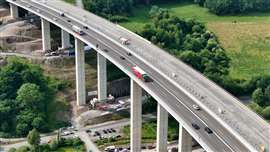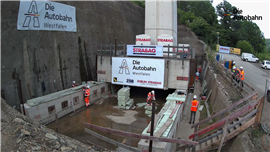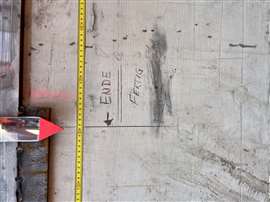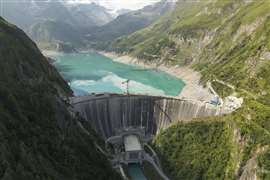Read this article in Français Deutsch Italiano Português Español
Video: How an entire 485.5m-long bridge was shifted sideways
07 July 2025
A concrete giant weighing thousands of tonnes slid sideways into place in the German state of North Rhine-Westphalia earlier this month – not on rails, but on Teflon.
The operation, which involved shifting a 485.5-metre-long viaduct section complete with piers and foundations, marks the first time such a transverse move has been executed on this scale in Germany.
Timelapse footage of the Rinsdorf viaduct’s repositioning on the A45 motorway (above) tells part of the story. But what it doesn’t show is the years of meticulous planning, risk assessment and precision engineering required to pull it off.
The project is part of a broader scheme to modernise key infrastructure along the A45, a vital motorway corridor connecting the Ruhr region with Frankfurt that crosses a series of deep valleys along its route.
Strabag, working as lead partner in a consortium with Bickhardt Bau for German federal highway authority Die Autobahn, began work on the viaduct in 2017. The neighbouring Rälsbach viaduct is also being renewed under the same programme.
The original Rinsdorf viaduct, constructed in the 1960s sits about halfway between Dortmund and Frankfurt, and had reached the limits of its design life. “It had to be replaced by a new structure because traffic volume had increased massively in the decades since its construction and are expected to continue to increase,” Wolfgang Schlensorg, business unit manager of Strabag’s Bridge Construction Centre, told Construction Briefing. “Its replacement is part of a huge traffic project: the renewal of the bridges along the A45 motorway and the almost continuous six-lane expansion of the highway.”
 The transverse shift of the 485.5m-long structure took around 20 hours to complete (Image courtesy of Strabag)
The transverse shift of the 485.5m-long structure took around 20 hours to complete (Image courtesy of Strabag)
Why slide a bridge sideways?
The decision to carry out a transverse shift of the viaduct rather than build in situ was largely dictated by traffic management and the geometry of the original design. The original Rinsdorf viaduct had not been built as two separate decks for each direction of travel but as a single structure. That presented a challenge when it came to maintaining the flow of traffic along the Autobahn while demolition of the original structure and construction of its replacement were undeway.
The solution was to build the first half of the new bridge structure offset by just over 20 metres to one side of the original viaduct. That enabled it to carry traffic while the original bridge was demolished. The second new section was then constructed in place of the original. Once complete, the first section was shifted transversely into its final position alongside the second.
“The new construction of one half of the bridge, offset by 20.6 metres to the side, and its subsequent transverse shift were necessary… to allow traffic to continue to flow without interruption during the entire construction period,” said Schlensorg. “Due to the size of the Rinsdorf viaduct, the transverse displacement of a bridge section including piers and foundations was the preferred option for reasons of time and cost.”
Transverse shifting of bridges is not in itself unusual. Strabag said it bridge construction teams regularly carry out shifts either of bridge superstructures or complete shifts of smaller frame structurres.
What has made this particular project rarer and more complex has been shifting an entire structure of this size (nearly half a kilometre long and 72m high), including its piers and foundations.
 The base of one of the bridge piers as it was shunted into position by hydraulic jacks (Image: Still taken from Die Autobahn timelapse video)
The base of one of the bridge piers as it was shunted into position by hydraulic jacks (Image: Still taken from Die Autobahn timelapse video)
Engineering in motion
The operation, in early June, took more than 20 hours. A synchronised system of 24 hydraulic jacks – four on each of the bridge’s six piers – pushed the structure into its final position at a pace of roughly one metre per hour.
To allow the concrete mass to glide smoothly over the shifting tracks, Strabag laid specially prepared Teflon (PTFE) sliding pads between the foundations and the base slab. These were treated with a specialist lubricant to minimise friction. The viaduct was moved in 15 precise phases, each measuring 1.4 metres in length.
The operation marked the culmination of years of design and coordination. “The transverse shift of the Rinsdorf viaduct has been comprehensively planned and calculated well in advance,” Strabag told Construction Briefing. “Specialist planners reviewed and confirmed the feasibility of the project during the design phase prior to 2017… the concept had to be finalised before the shunting foundations were built in 2018.”
Risks and mitigation
 A marker showing the end point of the shifting operation (Image courtesy of Strabag)
A marker showing the end point of the shifting operation (Image courtesy of Strabag)
One of the biggest technical uncertainties was the performance of the sliding interface, given the age of some components. “The main risk [was] in the sliding joint, as the interaction between stainless steel sheet and PTFE plates… could not be predicted exactly over the relatively long sliding distance,” Strabag explained. “Some parts had to be installed seven years before the displacement, meaning that this material was subject to ageing under the pressure of the structure.”
Additional work also had to take into account the deformation effects caused by temperature fluctuations and solar radiation. This was especially important because two central piers were firmly connected to the superstructure and therefore particularly sensitive to uneven deformation.
Despite these challenges, the shift proceeded exactly as modelled, with no unplanned issues.
Digital precision
One of the key innovations was a new digital control system developed by Strabag for synchronised hydraulic movement. “It takes into account environmental influences such as wind and structural deformation in real time during shunting, thanks to integrated monitoring and measurement technology,” said Schlensorg.
While not a reinvention of the transverse shift method, the technology represents a refinement and scaling-up of established practice. “We have further developed the proven technology and… implemented the complete shift in this significantly larger dimension,” Strabag said.
Strabag confirmed that the same digital control system will be applied on future projects of similar complexity.
Learnings for the sector
Strabag’s experience at Rinsdorf points to a broader trend in Europe’s infrastructure renewal programmes: the need to balance modern construction methods with minimal disruption to existing transport flows. Innovative sequencing, digital planning tools, and greater confidence in complex manoeuvres like substructure shifts are helped contractors to de-risk such complex operations.
The Rinsdorf team takes pride in what has been achieved. “Everyone involved is very proud of the smooth progress and the fact that the forecasts for the shunting have come true throughout. It is a great result that was made possible by strong teamwork,” said Schlensorg.
The rest of the project is due for completion by the end of this year.
STAY CONNECTED


Receive the information you need when you need it through our world-leading magazines, newsletters and daily briefings.
CONNECT WITH THE TEAM











